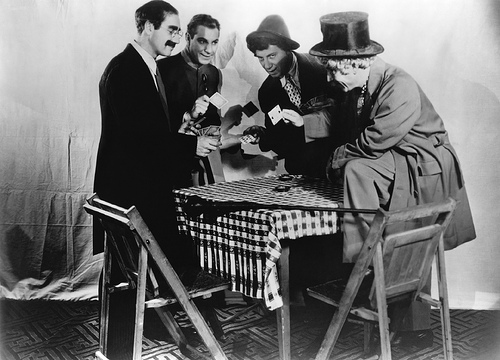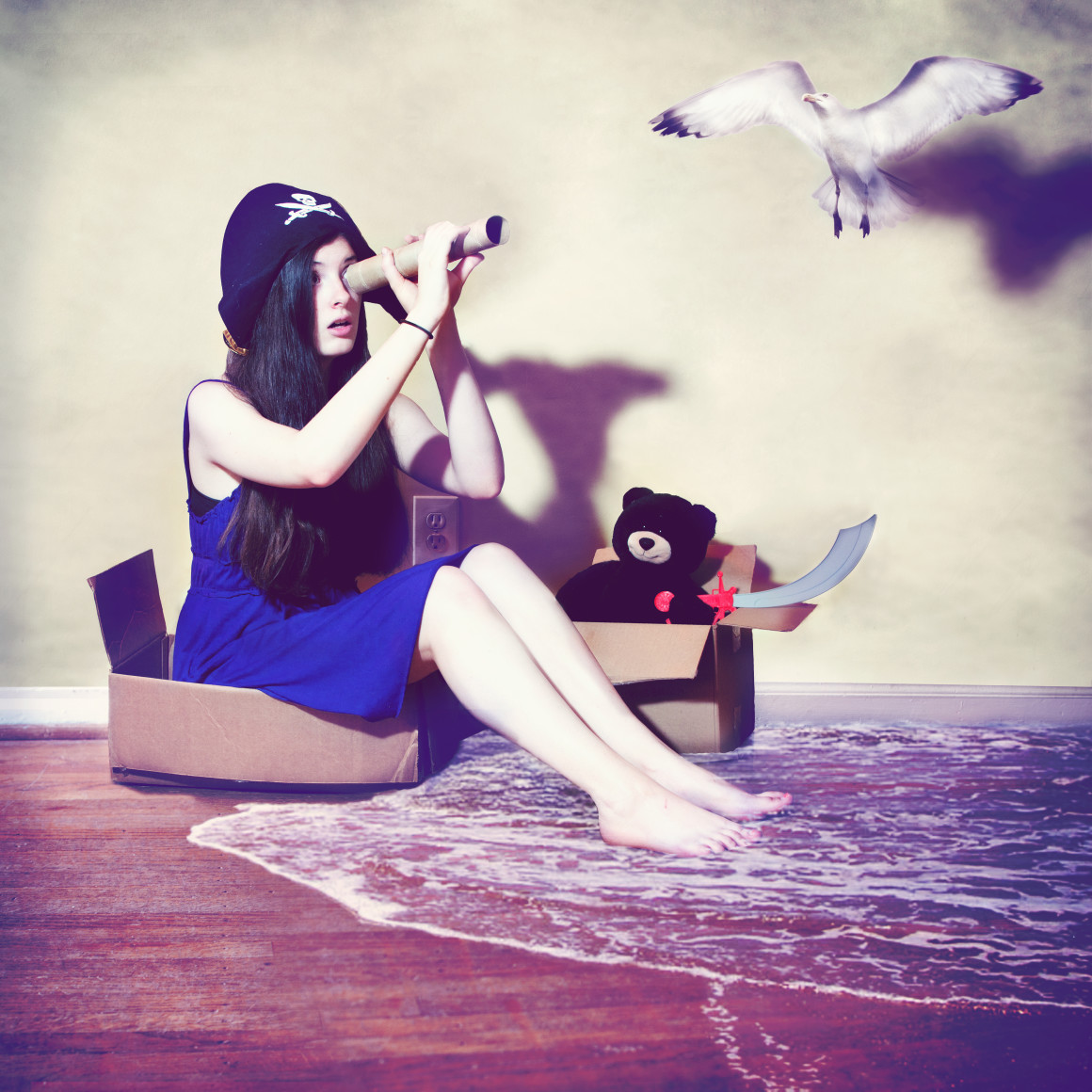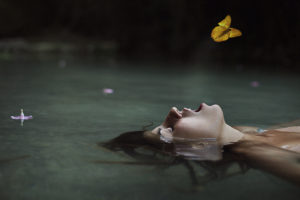When I was 29 years old, I jumped out of an airplane for the first time. Until then, my idea of an extreme sport had been jaywalking. But my sister had been trying to get me to do it for years, and since she was the women’s freestyle skydiving world champion nine years in a row and had survived more than 5,000 jumps without injury, I figured I’d probably be okay. So I said yes.
At the airport I received my instructions. I would be strapped to an experienced jumper called a tandem master. There were only two things to remember: 1) let go, and 2) breathe. Why were they telling me to breathe? I was hoping to get more helpful information, like how to hijack a small aircraft and fly it to Mexico. “You’re going to love it,” my sister reassured me.
We boarded the plane and took off—3, 7, 10 thousand feet. At 13,000 feet, the tinny little thing was shaking like a sardine can. It was time. The tandem master and I shuffled like beetles in heat onto the wing. Then it hit me: I am standing on the wing of an airplane 13,000 feet above the ground attached to a complete stranger. There was only one way down. This was really happening.
“LET GO!” a voice commanded. Four billion years of genetic memory kicked in screaming, “DO NOT, UNDER ANY CIRCUMSTANCES WHATSOEVER, LET GO!” I let go. AAAAAAAA! Wind whipped my face and roared in my ears. My nostrils exploded and my eyeballs threatened to eject. I was plummeting at 120 mph. My whole body braced against the onslaught of sensation. What was that second instruction, again????? Oh yeah! I gasped for air.
Then my sister came into view. She was waving at me and beaming an ecstatic “Isn’t this just the greatest thing EVER?!” grin, then glided over, kissed me delicately on the cheek, and swooped away spinning and flipping like a wild animal released from captivity. Pure play! I stared at her in awe as my own graceless biomass plunged straight down. Pure physics! The next thing I knew I got the little “time to pull the ripcord” tap on the shoulder. I reached frantically, fumbled, grabbed, and yanked. The canopy opened and suddenly everything changed. I took my second deep breath and began to make sense of my situation.
 It was simple; the sky was vast and blue and I was floating in it. I marveled at the spectacle as I drifted slowly down. Then a voice broke the spell, “You can let go of my thumb now!” I had mistaken my tandem master’s thumb for the ripcord and had been clutching it fiercely for the past 15 minutes so that I wouldn’t have to pay the $20 ripcord replacement fee. I let go. He breathed. Eventually, we landed. I wondered when I could do it again.
It was simple; the sky was vast and blue and I was floating in it. I marveled at the spectacle as I drifted slowly down. Then a voice broke the spell, “You can let go of my thumb now!” I had mistaken my tandem master’s thumb for the ripcord and had been clutching it fiercely for the past 15 minutes so that I wouldn’t have to pay the $20 ripcord replacement fee. I let go. He breathed. Eventually, we landed. I wondered when I could do it again.
My next opportunity came sooner than I expected. A week later I was strapped, as it were, to a different kind of master. I was moving into a yoga ashram for a few months to study with a spiritual teacher. He told me there were only two things to remember: 1) let go, and 2) breath. Déjà vu. This time, instead of letting go of an airplane wing, I was supposed to let go of my rickety little ego and free-fall into my unbounded true nature. It sounded great: no threat of bodily injury, no cost for the ripcord, no problem! I sat, closed my eyes, and settled down. That’s when 30 years of ego identification kicked in and screamed, “DO NOT, UNDER ANY CIRCUMSTANCES WHATSOEVER, LET GO!” Problem.
Like my sister, my teacher radiated an infectious exuberance as he leapt, spun, and twirled, free-falling through life with grace and mastery. He was in a perpetual free fall and it was pure play. Next to him, I felt like a heap of clenched flesh holding on for dear life. At the same time, I recognized the quality of freedom I saw in him. I feel it when I dance and sing, or during great conversations, watching a sunset, or making love.
We don’t always need to strap ourselves to a master in order to let go. Most of us have experienced these magical moments spontaneously when, without planning or preparation, our well-socialized, incessantly monitored identity falls away and our whole being leaps into play. All those rules, those laws and regulations, all the training and inhibitions disappear and our soul unfurls into a vast sense of space. What a relief, not to be so damned preoccupied, so self-absorbed, for one blissful minute.
We can feel that relief and freedom when we’re fully present, and we’re fully present when we play. As the renowned psychologist Charles Schaefer put it, “We are never more fully alive, more completely ourselves, or more deeply engrossed in anything than when we are playing.” Each time we play, it’s like a mini free fall in which we catch a glimpse of our true nature.
I’ve had teachers of all kinds. Most tell me that if I want to be free, I have to be serious, that freedom requires a lot of hard work. Discipline? Yes, but not seriousness. As the great revolutionary player Emma Goldman put it, “If I can’t dance, I don’t want to be part of your revolution.” Well, if I can’t play, I don’t want to be part of my own evolution. After 10 years of exploring the dynamics of evolution in the cosmos, culture, and psyche, strapped to a motley array of play masters from labrador retrievers to clandestine insurgent rebel clowns, I am happy to say that evolution is play. Giant sequoias, jellyfish, and broccoli were all brought to you by a universe in radical play. It is how life in all its forms, at every scale, explores, iterates, and finally lands on something that works, while having a big exuberant romp along the way.
So why would our own evolutionary future be any different? If we are going to succeed as individuals in a rapidly changing world, much less survive as a species, we are going to need the radically flexible, resilient genius of play. It is what we were born for and what we will blossom into if we are to survive.
If you’re reading this article, then a part of you knows that there is a huge cost to losing touch with your playful self. It’s like spiritual constipation. The sense of flow and ease stop and you get all clogged up. Life becomes flat, gray, and hollow. You feel rushed, tired, cranky, and depressed, and if the person in front of you in traffic doesn’t speed up already … well, let’s just say you’re a little reactive. If you had a high temperature, a rash, or visible bruises, you’d take your condition more seriously. But when your soul gets play-sick and your condition is seriousness itself, many of us (more than 118 million in the U.S. alone) take antidepressants. In the United States, play sickness is an epidemic.
The science is clear on this: Play is good for all warm-blooded organisms. The consensus from biologists and psychologists, derived from more than a century of observing animal and human play, is that play is not a luxury. It’s necessary for advanced mammals to survive. It prepares us to respond quickly to the unexpected. It makes us more capable organisms.
 It also restores our health. When Norman Cousins healed himself of a life-threatening disease by watching and laughing to hours of the Marx Brothers, he got a lot of people thinking seriously about laughter. One of them was Dr. Lee Berk from Loma Linda University in California. Dr. Berk’s research has revealed that after laughing we have a stronger heart, lower blood pressure, lower cortisol levels, higher serotonin levels, and a stronger immune system. It turns out play lengthens your life, helps women select a trustworthy mate (men who are playful, or who can play with children, are less likely to be rapists or murderers), and makes you successful at work (people like working with playful people). An article in the New Scientist takes these claims a step further, arguing that play improves overall brainpower. For many primates, the very act of playing strengthens and extends the number of neural connections in the brain. Neuropsychologist Stephen Siviy put it simply: When observing brain chemistry under experimental conditions, he saw that “play just lights everything up.”
It also restores our health. When Norman Cousins healed himself of a life-threatening disease by watching and laughing to hours of the Marx Brothers, he got a lot of people thinking seriously about laughter. One of them was Dr. Lee Berk from Loma Linda University in California. Dr. Berk’s research has revealed that after laughing we have a stronger heart, lower blood pressure, lower cortisol levels, higher serotonin levels, and a stronger immune system. It turns out play lengthens your life, helps women select a trustworthy mate (men who are playful, or who can play with children, are less likely to be rapists or murderers), and makes you successful at work (people like working with playful people). An article in the New Scientist takes these claims a step further, arguing that play improves overall brainpower. For many primates, the very act of playing strengthens and extends the number of neural connections in the brain. Neuropsychologist Stephen Siviy put it simply: When observing brain chemistry under experimental conditions, he saw that “play just lights everything up.”
The joy of play doesn’t just keep us alive; it makes us want to live. It’s no fun living in the gray box of a predictable, controlled life, or always working hard and holding it together so that we might be free one day down the road once we’ve retired or there’s no more global warming. We feel half-dead. We know there’s more. Our souls are crying for the burst of color and belly laughs, the zest and intimacy of play. Play is the cup that runneth over, the “YES!” to existence and to our place in that existence. So let yourself play today. You’re going to love it—just let go and breathe.
+Want some inspiration for your play today? A few practices: Remember the Pure Joy of Play, Strike a Pose, and Become a Rogue Agent of Delight.
Photos (top to bottom): "Child's Play" by Rachel Adams from Flickr (CC), "Tandem Teigan Elizabeth Henry" by Skydive Andes Chile from Flickr (CC), "The Marx Brothers" by Insomnia Cured Here from Flickr (CC)






